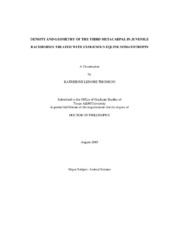| dc.description.abstract | The effect of exogenous somatotropin (eST) on bone changes were evaluated in
twenty-nine juvenile horses in race training using radiographs of the third metacarpal
obtained over the course of a 128 day research project. A biodensitometer was used to
measure bone density, and a micrometer was used to measure cortical bone width and
medullary cavity width. Fifteen horses were given daily intramuscular injections of eST
and fourteen horses were given daily intramuscular injections of sterile saline and served
as the control group.
By day 128, the increase in total radiographic bone aluminum equivalence (RBAE)
was significantly greater in the eST horses than in the control horses. The increases in
RBAE in the dorsal and the medial cortices were greater in the eST horses than in the
control horses, but these differences were not significant. There was a trend for changes
in the ratio of RBAE in the dorsal to palmar and in the medial to lateral cortices to be
greater in the eST than in the control horses.
By day 128, the increases in both the dorsal and the medial cortical bone width were
significantly greater in the eST than in the control group of horses. The eST horses had a
significantly greater decrease in dorsal to palmar medullary cavity width, and increase in
dorsal to palmar bone diameter than the control group. A computed index of dorsal
cortical bone increased significantly more in the eST than in the control group.
The stresses applied to bone are greater in the dorso-medial direction in racehorses.
To decrease the strain, bone must either increase in bone mineral density, cortical width,
and/or bone diameter. Both the eST group and the control group did make these changes in bone over time, but the eST group more effectively remodeled and modeled bone to
increase the strength of the third metacarpal than did the control group of horses.
In this research project, exogenous somatotropin treatment had a positive effect on the
density and geometry of the third metacarpal. These changes are believed to result in a
decreased risk of bone injury to the eST treated horses. | en |


